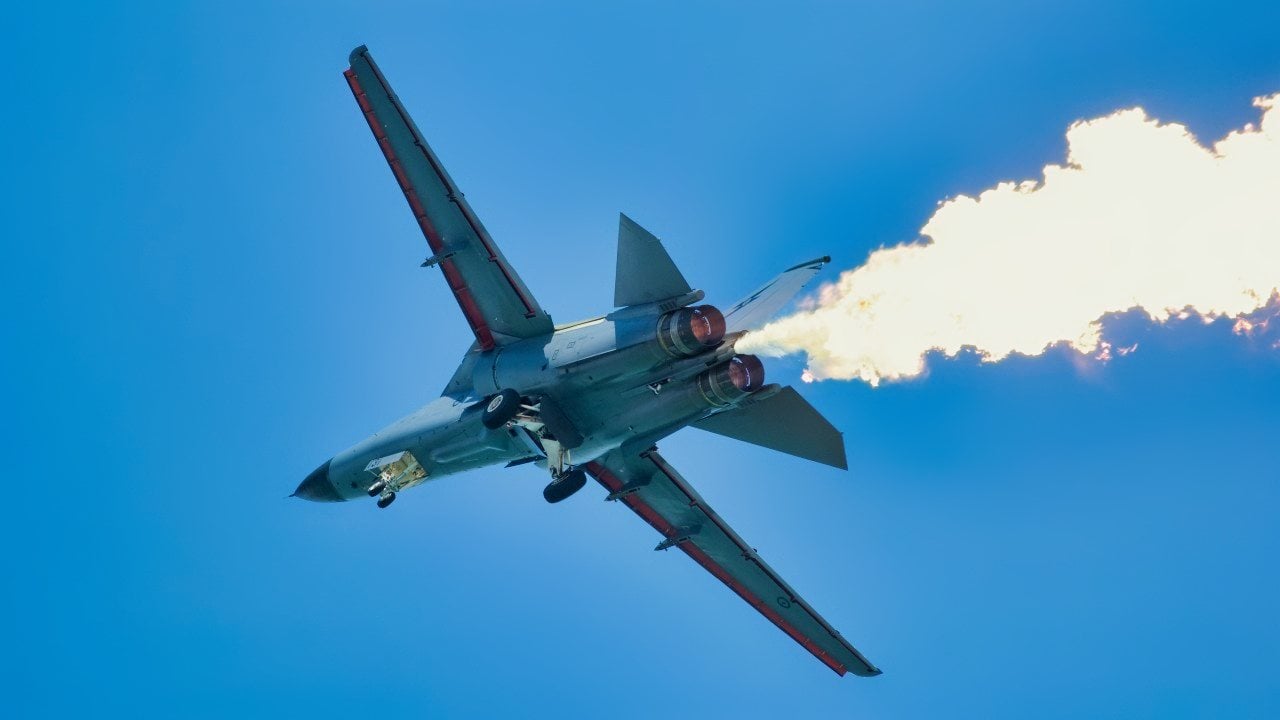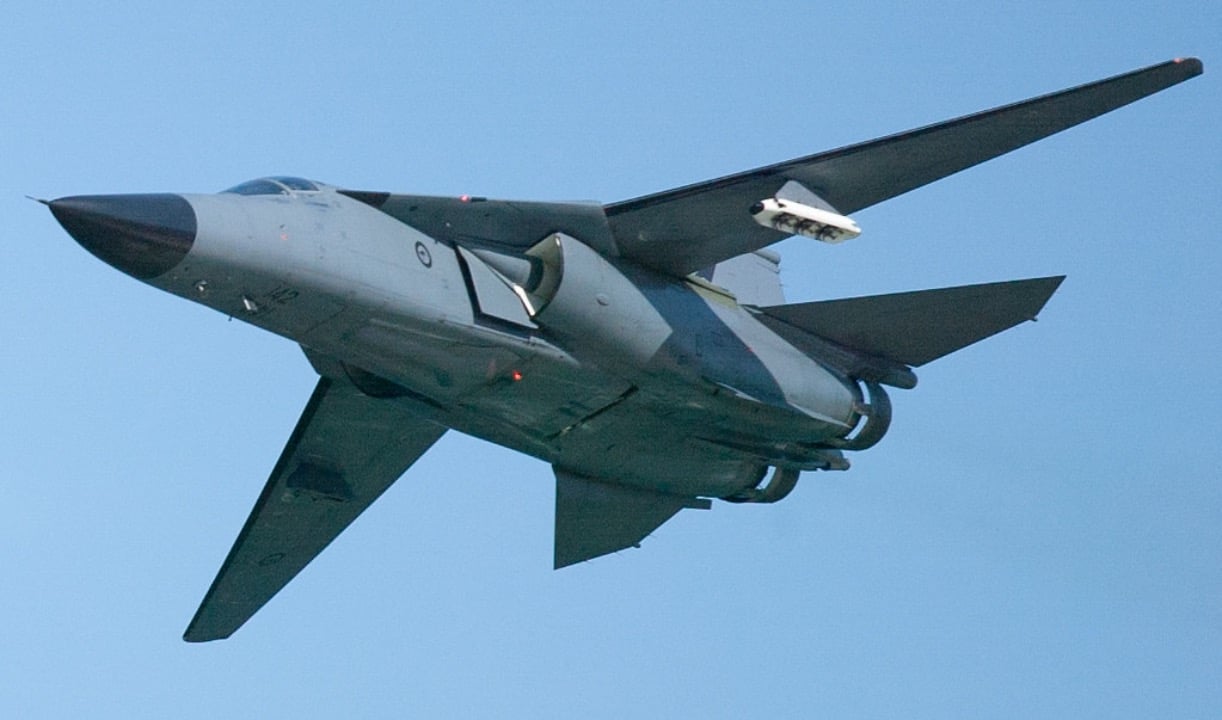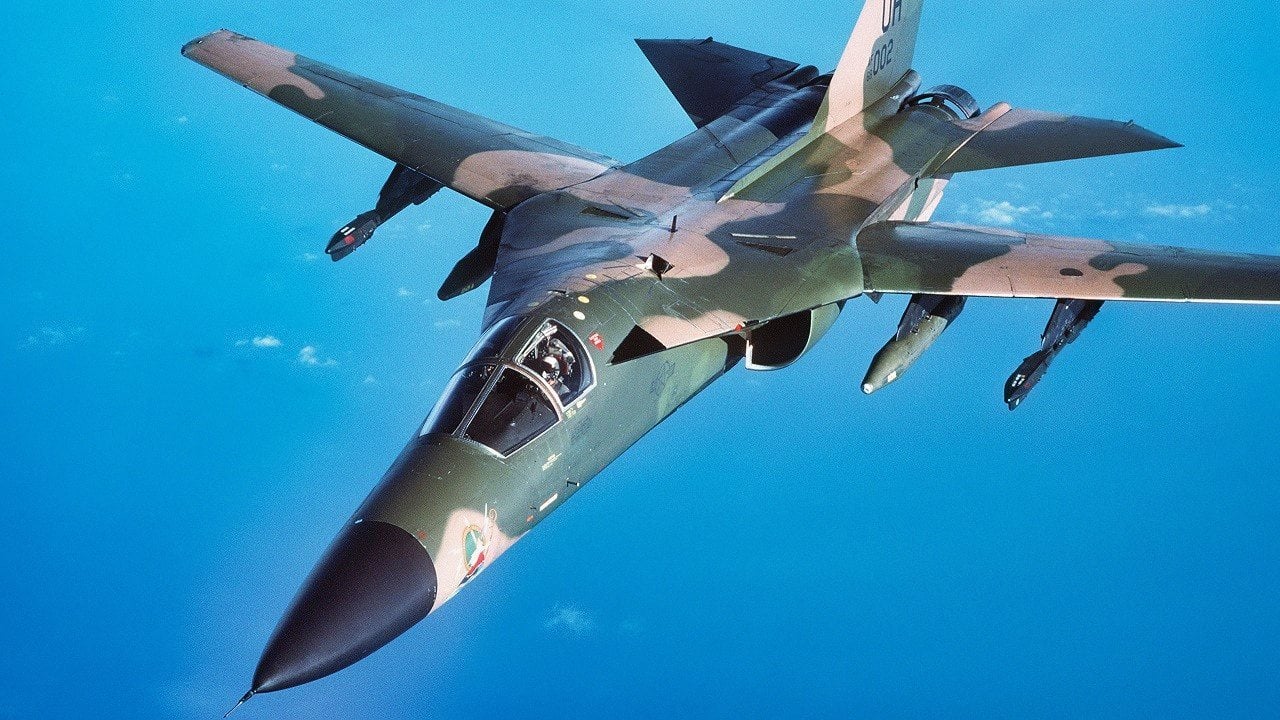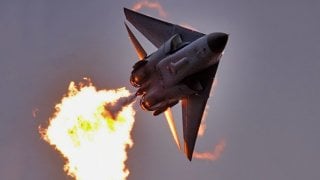F-111 Aardvark: Vietnam and Gulf War Sensation (It Almost Killed Qaddafi)
The General Dynamics F-111 Aardvark was a low-altitude strike plane born out of a shotgun wedding between competing Air Force and Navy requirements—with Defense Secretary McNamara as the minister.
The General Dynamics F-111 Aardvark was a low-altitude strike plane born out of a shotgun wedding between competing Air Force and Navy requirements—with Defense Secretary McNamara as the minister. Despite its troubled adolescence, it grew into a capable high-tech night bomber that lasted decades in service, noted for its sleekly elegant profile.
Troubled Conception
In the early 1960s, the Air Force came to realize that new, radar-guided surface-to-air missiles such as the Soviet SA-2 could reach its slow, high-altitude bombers. In response, it devised a new concept: a smaller long-range supersonic bomber that could skim close to the ground, below radar systems. At the same time, the U.S. Navy was looking for a fast, long-range carrier-based interceptor armed with air-to-air missiles that could take out Soviet bombers from a distance.
Newly appointed Defense Secretary Robert McNamara was convinced that a single aircraft could satisfy both requirements, thereby saving on development costs. The Army and Navy were less keen on compromising their visions but were forced to cooperate on the so-called TFX program. A contract was awarded to General Dynamics in 1962. Because the design was smaller than Air Force strategic bombers, and the service eschewed the “attack” designation used by the Navy, it was designated with an “F” for fighter.
Revolutionary Design
The F-111 was built around two powerful yet fuel-efficient TF30 turbofan engines with new afterburner technology. A capacious fuselage could accommodate bomb loads of up to 31,000 pounds and fuel for missions up 2,500 miles long, with external tanks adding another 1,000 miles. The large plane weighed twenty tons empty—or more than twice that loaded.
The designers of the F-111 faced a challenge: they needed a plane that could fly at very high speeds, but still take off or land on a short runway. Using smaller wings would create less drag, allowing the aircraft to fly faster—but also create less lift, requiring the aircraft achieve higher speeds before it take off, in turn necessitating a longer runway. For example, the other supersonic fighter-bomber of the era, the F-105 Thunderchief, had very small wings—and required airstrips over a mile long for takeoff, limiting which airfields it could operate from.
The F-111’s designers adopted the new technology of variable-geometry, or “swing” wings. These permitted the wings to swing out during takeoff to generate maximum lift and then would tuck inward midflight to achieve higher speeds. The F-111 was the first of several major designs that used the technology.
The two-man crew sat side by side in a cockpit pod. If they needed to escape, a rocket boosted the pod upward, which then floated to the ground on a parachute, just like a space capsule.
A key innovation was the F-111’s revolutionary new terrain-following radar, which mapped the ground directly in front of the plane and then automatically adjusted the flight path to avoid a collision. This allowed F-111s to fly as low as two hundred feet above the surface and make precise adjustments at high speed without crashing—even when flying at night, or in bad weather conditions. The F-111’s talent for hunting in darkness, nose close to the ground, was what earned it the appellation “Aardvark.”
Early F-111s did show promise, capable of flying over the speed of sound at Mach 1.2 at low-altitude, or more than double that (Mach 2.5) at high altitude—all the while requiring only a 2,000-foot runway to land. It was the first tactical aircraft to cross from the United States to Europe without mid-air refueling.

However, the F-111’s design was biased in favor of the Air Force’s specifications. The carrier-based interceptor version, the F-111B, performed abominably in trials, struggling to exceed Mach 1. The expensive forced compromise that was the naval version was finally scrapped, leaving everyone millions of dollars poorer. Many of the more promising design elements of the F-111B made it over to the F-14 Tomcat, however.
Deployment in Asia
The Air Force F-111s didn’t have an auspicious debut in combat. After a detachment of six F-111As was deployed to Vietnam in 1968, three of them crashed in just fifty-five missions, all of the accidents linked to defective wing stabilizers. The Air Force was forced to withdraw the F-111 and correct the flaw at a cost of $100 million.
It wasn’t until the Linebacker raids in 1972 that the F-Aardvark finally demonstrated its potential. Skimming beneath North Vietnam’s extensive radar network at night, F-111s blasted North Vietnamese airfields and air defense batteries, weakening the resistance to incoming B-52 raids. Aardvarks didn’t require the fighter escort, electronic warfare support, or midair refueling that other bombers required, and could operate in inclement weather. Only six F-111s were lost in combat over the course of 4,000 missions during the war, one of the lowest loss rates of the war.
F-111s ended up participating in the last combat operation undertaken by the U.S. military in South East Asia, when the Cambodian Khmer Rouge seized the container ship S.S. Mayaguez in May 1975. Two Aardvarks diverted from a training flight were the first to locate the Mayaguez. Later, an F-111 sank a Khmer Rouge patrol boat escorting the seized ship.
Variants
563 F-111s of all variants were built. After the F-111A, the F-111D and E models upgraded the Aardvark’s electronics and engine inlets, and increased the thrust of the engines. Another variant, the FB-111, was designed as a strategic bomber with improved engines, stretched two feet longer to accommodate additional fuel. Seventy-five of these served in Strategic Air Command units.

The F-111C was sold exclusively to Australia. It incorporated a mixture of design elements of the FB-111 and F-111E.
The definitive F-111F sported engines with thirty-five percent more thrust, upgraded radar and a Pave Tack infrared targeting pod that allowed the crew to identify targets on the ground and hit them with precision-guided munitions.
Starting in the mid–1970s, forty-two F-111As were converted into unarmed EF-111A Raven electronic jamming platforms at a cost $1.5 billion. The EF-111’s key system was an ALQ-99E jamming pod that emitted radiation that scrambled radars in the vicinity, permitting entire formations of aircraft to pass in its wake undetected. When active, the jammer’s current literally caused the hairs on the crew’s heads to stand as it crackled through the plane. Thus, the Raven was known as the “Spark Vark” to its pilots. The EF-111 is distinguishable by the receiver pod on the tail fin.
El Dorado Canyon Raid
The F-111 would return to the stage of world history in 1986 after the bombing of the La Belle nightclub perpetrated by Libyan agents in Berlin killed two U.S. servicemen. Reagan ordered an attack on Libyan dictator Muammar el-Qaddafi’s personal compound near Tripoli codenamed Operation El Dorado Canyon. It was an early attempt to assassinate a head of state by air attack.
An array of twenty-five SAM sites defended Tripoli. A squadron of eighteen F-111Fs carried out the main attack, joined by four EF-111 Ravens to electronically scramble the defense radars. A separate Navy strike hit targets near Benghazi.
Because the United States couldn’t get approval from mainland European countries for the raid, the Aardvarks took off from the UK and had to circumnavigate Spain, increasing total flight time to thirteen hours. In all, they would need to be refueled six times on the roundtrip. It was the longest fighter mission in history.

As a feat of logistics, the raid was impressive—but unfortunately, both F-111’s performance and the conception of the operation as a whole left something to be desired. One F-111 was shot down, probably by a SAM, and its crew was lost. Four were unable to release weapons because of avionics failures, and one F-111 had to land in Spain because of an overheating engine. Seven missed their target, with several of the bombs landing in civilian areas, nearly hitting the French embassy.
Qaddafi managed to escape thanks in part due to a last-minute warning from the prime minister of Italy. Eight of his children and his wife were wounded, and his infant adopted daughter Hanna reportedly killed. (There is some controversy as to Hanna’s identity and whether she survived). Though Qaddafi was shaken, he went on to instigate further terrorist attacks, notably the hijacking of Pan Am 73 and the bombing of Pan Am 103 over Lockerbie, Scotland.
Aardvarks and Ravens Over Iraq
On January 17, 1991, the opening night of Operation Desert Storm, Aardvarks zipped across the desert at a low altitude, targeting Iraqi air defenses and key military installations with laser-guided bombs. Meanwhile, EF-111 Ravens accompanied strike packages of coalition aircraft flying deep into Iraq, their jammers disabling Iraqi air-defense radars. In all, sixty-six F-111Fs and 18 F-111Es were deployed in the 1991 Iraq War, flying 5,000 missions.
Contrary to popular belief, the Iraqi Air Force didn’t make things a cakewalk on the first day. Two F-111s were hit by infrared-guided R-23 missiles fired by MiG-23s. Another was struck by an R-60 missile shot by a MiG-29. In all three cases, the hardy Aardvarks made it back to base.
An EF-111 was not so lucky in February. While taking evasive maneuvers after detecting an enemy plane, it crashed into the ground, losing both crew members.

